Repairing a Burst Pipe | Burst Pipe Repair Cost | Fixing a Busted Water Pipe | How to Fix a Burst Pipe | Pipes Burst Under House
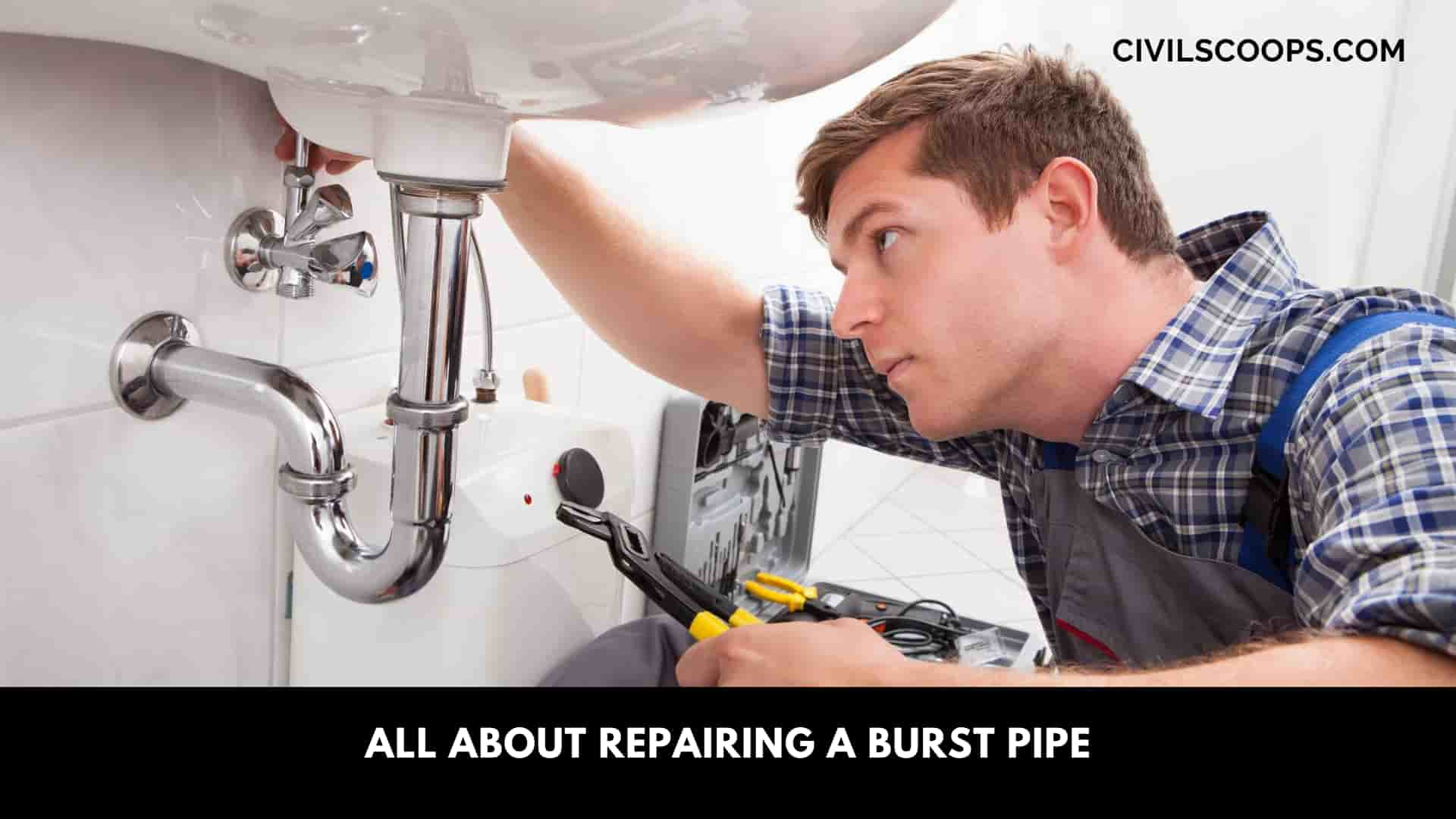
Table of Contents
Introduction of Repairing a Burst Pipe
Burst pipe means bursting of pipe in different circumstances as well as in different situations. Bursting of pipes results in severe damages in the plumbing on a house as well as severe damages in overall house systems as well.
There are various reasons which can cause the bursting of a pipe, such as:
Due to severe expansion and contraction of pipes in the winter season(which is particularly detrimental whenever coating Is not provided in the outer crush of a pipe). Direct contact of pipe in the surrounding soils.
The presence of sulfur in the soils is particularly detrimental to the pipe. Bursting of the pipe due to inadequate placing and leveling of the ground where the pipe is to be placed.
Repairing a Burst Pipe
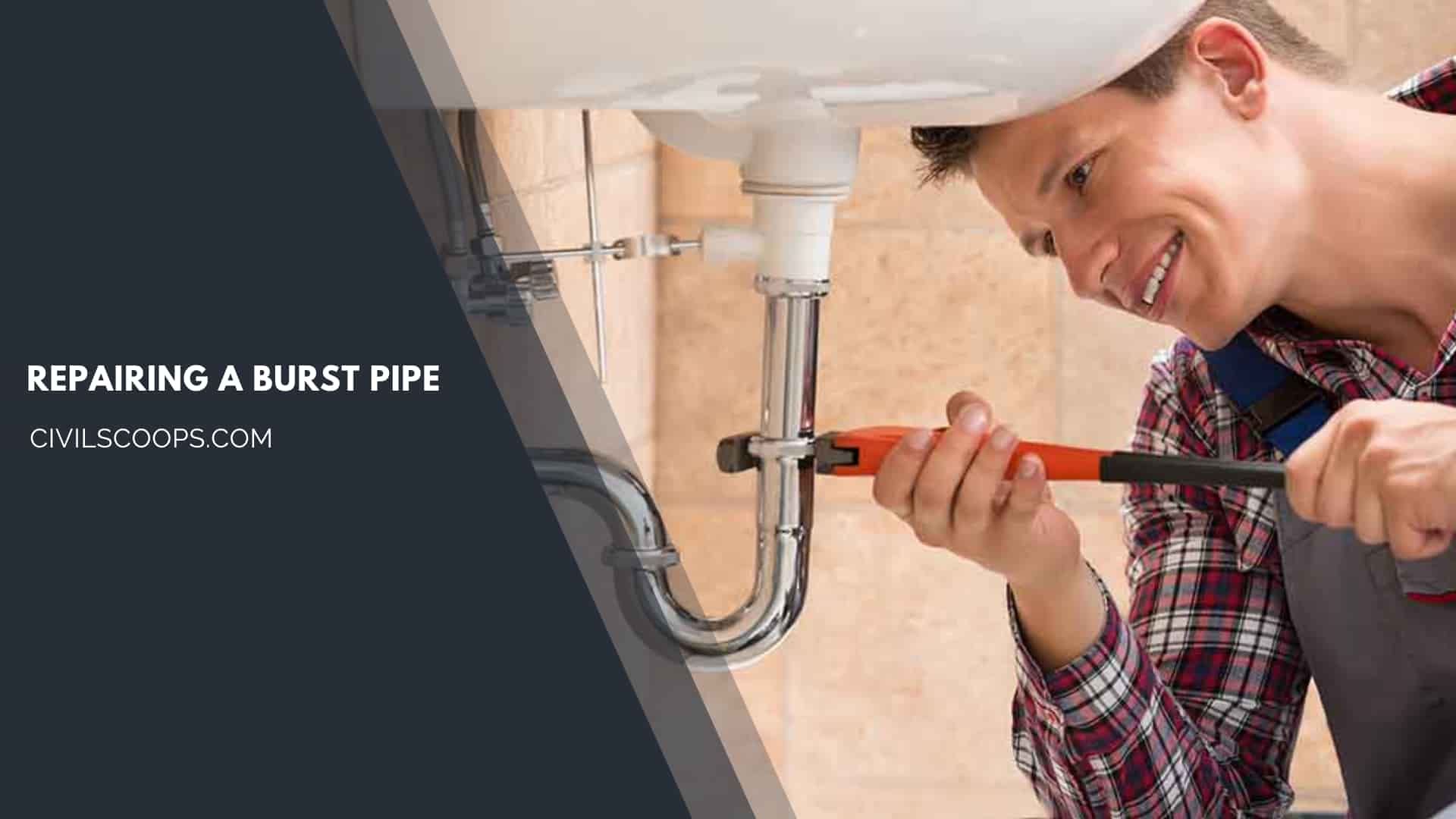
Repairing a burst pipe essentially requires various shouldering equipment, apart from the fact it requires various manpower as well. Just by adding a stop and waste valve, it can be ensured that the pipe does not freeze again.
Here are some materials which can be used to repair a burst pipe, they are:
- Mini-copper pipe cutter.
- Steel wool.
- Soldering paste.
- Lead-free solder.
- Torch kit.
- Good and branded half inch copper pipe.
- Half inch copper fittings.
- Stop & waste valve.
Also Read: All About Drywall Water Damage Repair
Useful Article for You
- Sheeps Foot Roller
- Wall Materials Interior
- Post and Beam Foundation
- Gable Roof Design
- Modulus of Rupture
- Dry Pack Mortar
- Roof Tiles Types and Prices
- Footing Step
- Vibrator Types
- Asphalt Floor
- Spandrel Beam
- Gradient Road
- Construction Beam
- Structural Shell
- Homemade Concrete Release Agent
- Kerb Stone
- Concept Drawing
- Width of a Brick
- Soffit Types
- Suspension Bridge Pros and Cons
Repair Procedure of Repairing a Burst Pipe

The steps of the repair process are as follows.
- Determine the location on the pipe where the pipe is busted or shows signs of bursting. So, it is required to choose such an area where the pipe can be most detrimental due to the surrounding weather effects.
- After locating the area, the main valve is required to be shut off from where comes I the pipe thus comes in the house as well. Open the lowest fixture of the house to drain out any type of water.
- To remove the desired section of the pipe a pipe cutter is use. Until it cuts through around the pipe the pipe cutters rotate and gradually tightening. With steel wool cut end of the pipe and any burrs off clean. Place a bucket around the cut area to catch any water remaining in the line.
- Temporarily remove the peacock from the valve. It is required to take care of the point that the valve should be in the right direction.
- A Section of copper pipe is cut to form an appropriate length. It is to make sure that a little extra length is cut to make a good fit. Be sure that the new water pipe is the same diameter as the existing water pipe.
- Use steel wool to both of the pipe ends and inside the stop and waste valve.
- Spread Soldering flux to the outside of the water pipe and internal face of the water pipe ad well t ensures proper fitting on the existing water pipe. Slide the valve fitting into the end of the pipe.
- For safety reasons, wear safety goggles, use a propane torch to heat the fitting and the pipe where they can connect. just at the end of the pipe of the blue frame hold the edge, for best results.
- Push about 2 inches of the solder into the joint to enable proper jointing with the valve and the pipe. Into the connection as well allow it to seep and heat will melt the solder. Solder completely around the pipe valve connection. Practice Soldering techniques on scrap pieces of pipe and copper fittings before trying it on the valve.
- Replace the peacock, open the main water line to check for leaks. Before temperature dips below the freezing point shut off the valve and open any spigots that are downstream of the valve. Then remove the peacock screw to drain the pipe. If any sections of the drain pipe are in the unheated area, cover them with foam pipe insulation.
Burst Pipe Repair Cost

The repair cost of burst pipes can be quite high including the man and materials. Due to the high cost of repair for a particular stretch of a burst pipe, it is very much recommended to control the flow and other parameters such that the pipe does not burst at all.
The rate of a plumber for fixing a burst pipe can be quite high as well starting from 85 dollars per hour. So, it is very much recommended to properly maintain the level of the soil and soil properties to prevent the bursting of pipe.
Also Read: All About SBC of Soil | What Is SBC of Soil | Safe Bearing Capacity of Soil
Burst Heating Pipe
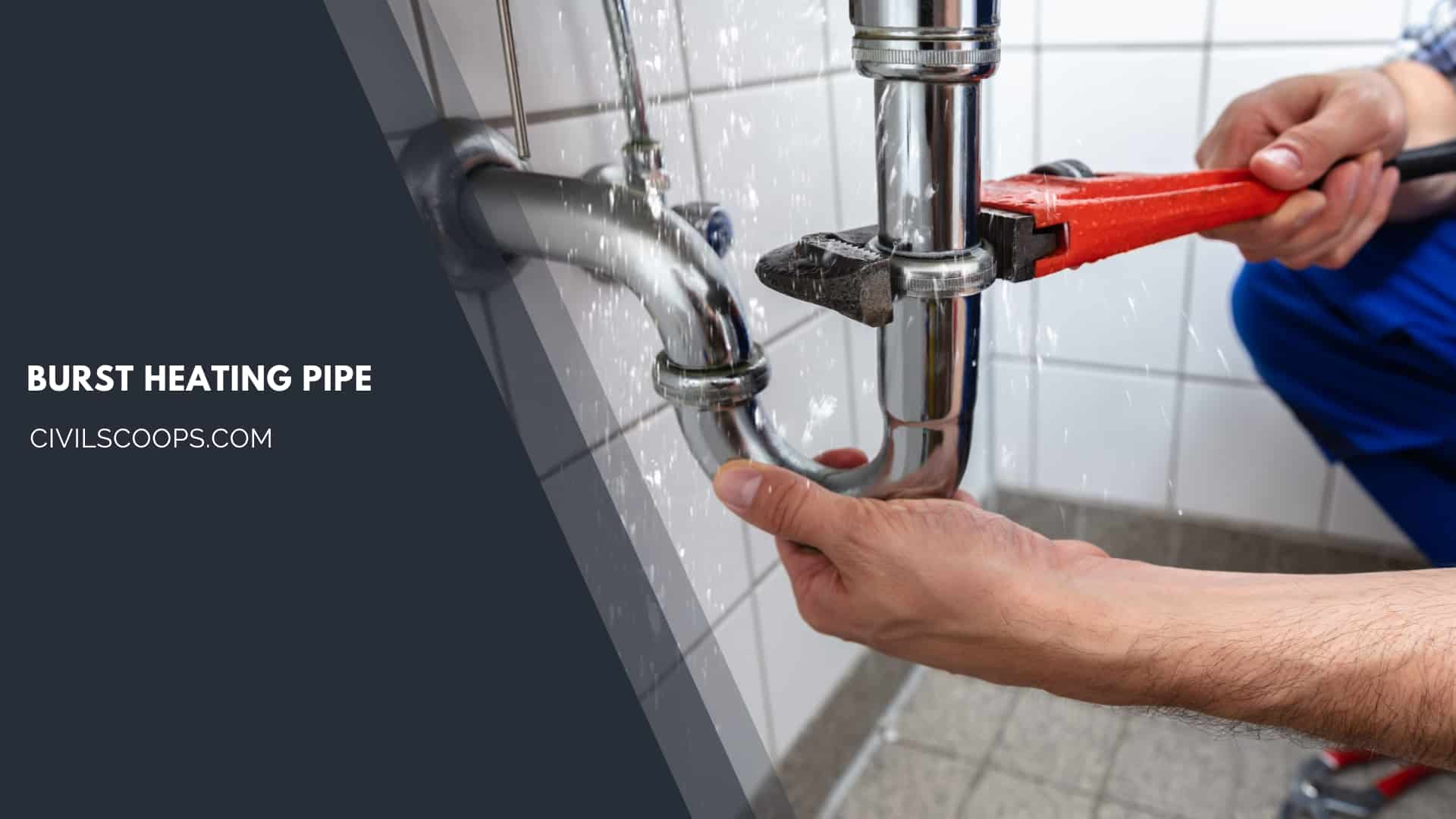
This is another very much detrimental defect in pipes. Maximum time it happens that due to submerged pipes, very severe heating can be produced which can be very much detrimental to the pipes.
Due to this very severe heating, pipes may burst unconditionally. Burst heating of pipes can cause severe damages to the plumbing system of a house.
Why Do Pipes Burst?
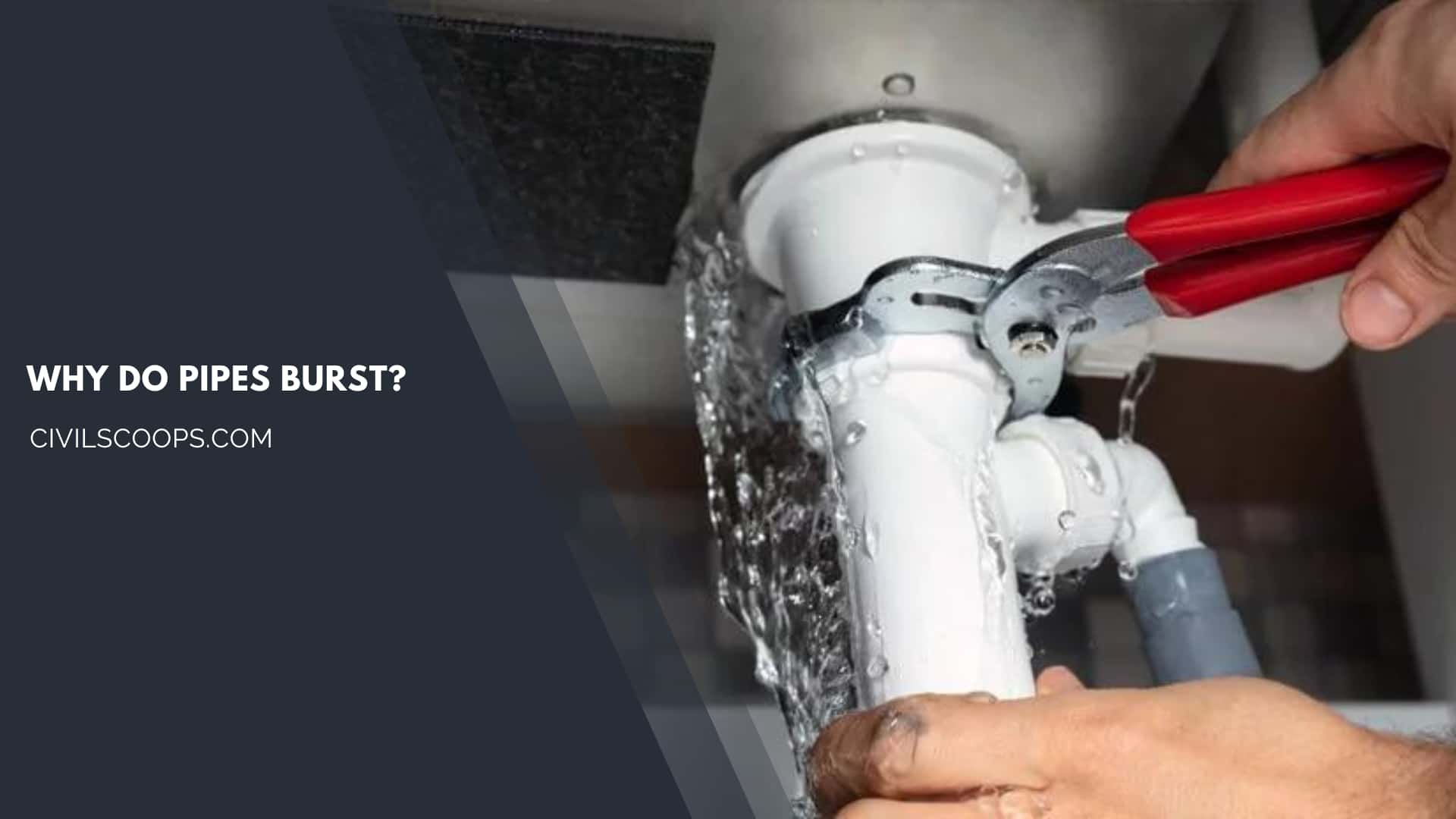
The reason behind the bursting of any pipes can be due to the various reasons, some of them are:
- Due to the unexpected weather changes, such as severe heat in the afternoon time and cold in the wintertime, and where this type of difference can be higher the chances of pipes bursting can be high in such situations.
- Due to the detrimental properties of the soil of a particular area, such as the presence of Sulphur content and supplied content, chemicals change and corrosion may occur between the constituents of soil and pipe material. Due to such reactions, pipes may burst unconditionally in any Atmospheric condition.
- Due to the improper levelling and inadequate flow of water within the pipe, pipes may burst at a very fast rate. Thus, to prevent the bursting of a pipe, the surrounding soils must be levelled thoroughly to ensure proper placing of pipe.
Fixing a Busted Water Pipe

There are have many steeps of fixing a busted water pipe that’s are below-
- At first, we have to determine the location on the pipe where the pipe is busted or shows signs of bursting.
- So, it is required to choose such an area where the pipe can be most detrimental due to the surrounding weather effects.
- After locating the area, the main valve is required to be shut off from where comes I the pipe thus comes in the house as well. Open the lowest fixture of the house to drain any water out.
- Temporarily remove the peacock from the valve. It is required to take care of the point that the valve should be in the right direction.
- And then use a pipe cutter to remove the desired section of the pipe. Until it cuts through around the pipe,the pipe cutter is rotate and gradually tightening.
- After that clean any burrs off and end of the cut pipe with steel wool. Place a bucket around the cut area to catch any water remaining in the line.
- A Section of copper pipe is cut to form an appropriate length. It is to make sure that a little extra length is cut to make a good fit. Be sure that the new water pipe is the same diameter as the existing water pipe.
- Use steel wool to both of the pipe ends and inside the stop and waste valve.
- Spread Soldering flux to the outside of the water pipe and internal face of the water pipe ad well t ensures proper fitting on the existing water pipe.
- Slide the valve fitting into the end of the pipe.
- For safety reasons, wear safety goggles, use a propane torch to heat the fitting and the pipe where they can connect just at the end of the pipe of the blue frame hold the edge, for best results.
- Push about 2 inches of the solder into the joint to enable proper jointing with the valve and the pipe. Into the connection as well allow it to seep and heat will melt the Solder completely around the pipe valve connection. Practice Soldering techniques on scrap pieces of pipe and copper fittings before trying it on the valve.
- In this way, we can be fixing a busted water pipe of the houses.
Also Read: All About of Plumbing Fittings | What Are Plumbing Fittings | Types of Plumbing Fittings
Pipes Burst Under House
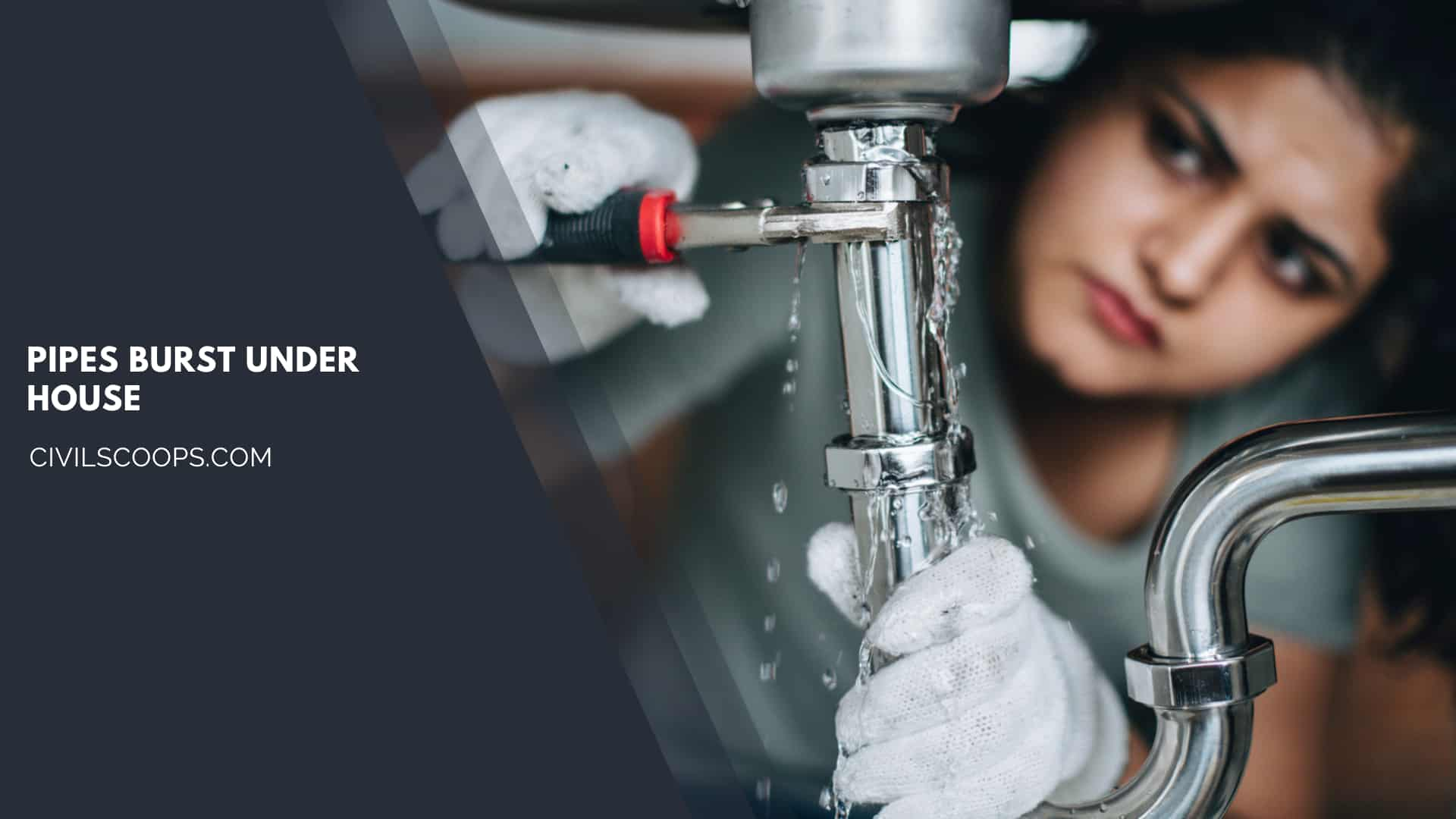
Many a time plumping pipes may exist beneath the house, which is particularly beneath the slab. Due to the pressure of the slab as well as the high pressure from the surrounding soils, a pipe may burst under the house. The signs of pipe bursting may be seen in a building from the following examples:
- Water leakage in slabs: Whenever any bursting of pipe occurs, water leakage can be found in slabs as well. Signs and markings of water leakage can be heavily found in slabs.
- Higher moisture content in soils: Due to the bursting of pipes water may leak out from the pipes, which correspondingly increases the moisture content of the surrounding soil, which is also responsible for the failure of the entire plumbing system of the building.
- Wet areas of grass beside the house.
- Damp patches on the carpet.
- A musty odor in certain rooms.
- The sound of running or rushing water when all the taps are turned off.
- Warm spots on the floor.
- An unexpected increase in the water bill of a particular family based on its water consumption.
- Low water pressure.
- Rising damp on walls when there are no significant rains.
Whenever a pipe burst under the house occurs, there can be various methods to fix it, which also might be a little expensive. Some of them are:
- Locating the position of the leak: At first, the location of the position of the leak is found out
- Then the best strategy for repair system is identified which is adopted in the house plumbing system for repairing the bursting pipe.
- While deciding the best strategy, the factors affecting the cost of the repair such as man materials are considered. The factors affecting the soil properties and characteristics are also considered while deciding the repair systems.
Useful Article for You
- How Much Does Hempcrete Cost
- How to Build a Lean to Roof
- How Dense Is Sand
- How to Make Mortar from Scratch
- How Tall Is a Kitchen Counter
- How to Use a Hand Sight Level
- How to Resurface Concrete
- How to Layout a Building
- How Is the Skeleton Similar to the Frame of a House
- How to Seal a Brick Wall
- How to Use Portland Cement
- How to Form a Monolithic Slab
- How to Get Rid of Gloss Paint Fumes
- How Are Bridge Foundations Built
- How to Calculate Fineness Modulus
- How to Measure Slump in Concrete
- How Does a Cantilever Bridge Work
- How Much Is Flagstone Per Square Foot
- How Tall Is a Cinderblock
- How Are Tunnels Built
Burst Water Pipes in Homes

When you understand a pipe is burst in your house, we have to find out the area from where water is licked. After locating the area, the main valve is required to be shut off from where comes I the pipe thus comes in the house as well. Open the lowest fixture of the house to drain any water out.
Temporarily remove the peacock from the valve. It is required to take care of the point that the valve should be in the right direction. And then use a pipe cutter to remove the desired section of the pipe. Until it cuts through around the pipe, the pipe cutter is rotate and gradually tightening.
After that clean any burrs off and end of the cut pipe with steel wool. Place a bucket around the cut area to catch any water remaining in the line.
For safety reasons, wear safety goggles, use a propane torch to heat the fitting and the pipe where they can connect. Push about 2 inches of the solder into the joint to enable proper jointing with the valve and the pipe.
Into the connection as well allow it to seep and heat will melt the solder. Solder completely around the pipe valve connection. Practice Soldering techniques on scrap pieces of pipe and copper fittings before trying it on the valve.
Why Do Water Pipes Sometimes Burst in Winter?

The reasons behind the pipes bursting in winter can be mentioned in the following:
- In the winter season, the outer temperature of the atmosphere becomes very low, while the inside of the pipe, the temperature is high due to continuous flowing of water and due to friction, additional heat is produced as well.
- Thus, in the outer crush of the pipe due to low temperature there is a tendency of the pipe to contract itself.
- While in the inside of the pipe, there is a tendency of the pipe to expand itself.
- Thus, severe stress is formed at the crust of the pipes due to severe expansion and contraction.
- Thus, if necessary, measures are not taken, there is a high possibility of the bursting of the pipe. That is the main reason for the frequently bursting of water pipes in the winter season.
How to Fix a Burst Pipe?
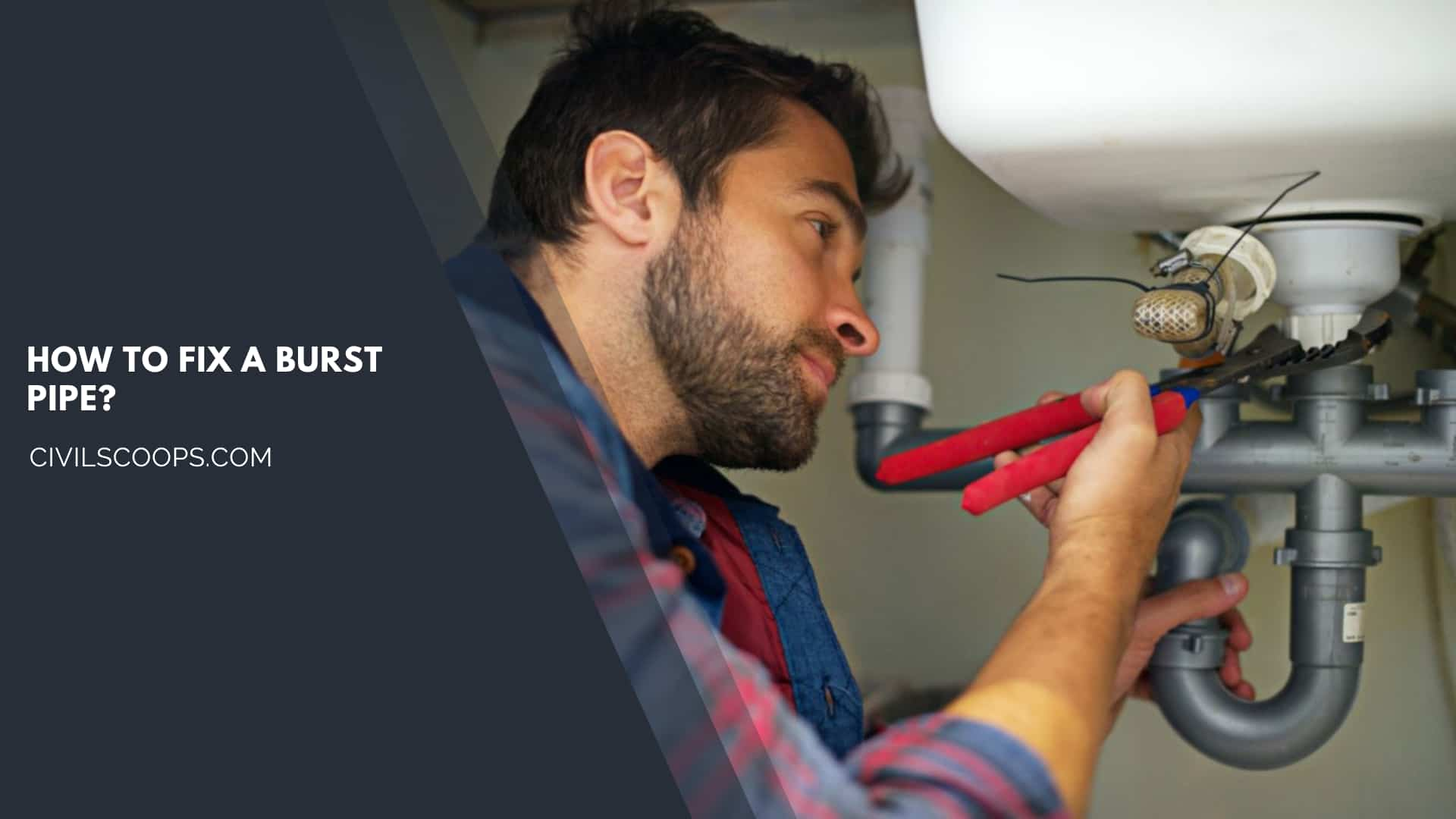
There are have many processes to fix burst pipes that’s are below.
- At first, we have to determine the location on the pipe where the pipe is busted or shows signs of bursting.
- So, it is required to choose such an area where the pipe can be most detrimental due to the surrounding weather effects.
- After locating the area, the main valve is required to be shut off from where comes I the pipe thus comes in the house as well. Open the lowest fixture of the house to drain any water out.
- Clean any burrs off and end of the cut pipe with steel wool. Place a bucket around the cut area to catch any water remaining in the line.
- Temporarily remove the peacock from the valve. It is required to take care of the point that the valve should be in the right direction. A Section of copper pipe is cut to form an appropriate length. It is to make sure that a little extra length is cut to make a good fit. Be sure that the new water pipe is the same diameter as the existing water pipe.
- Use steel wool to both of the pipe ends and inside the stop and waste valve.
- Spread Soldering flux to the outside o the water pipe and internal face of the water pipe ad well t ensures proper fitting on the existing water pipe.
- Slide the valve fitting into the end of the pipe.
- For safety reasons, wear safety goggles, use a propane torch to heat the fitting and the pipe where they can connect.
- For best results, hold the edge of the blue frame just at the end of the pipe.
- The heat will melt the solder and allow it to seep into the connection as well. Solder completely around the pipe valve connection.
- Practice Soldering techniques on scrap pieces of pipe and copper fittings before trying it on the valve.
- Use the same Soldering technique to install the new assembly to the existing water line.
- Depending on the installation, it may be necessary to use the copper fittings to connect the new sections of pipe to the existing water line. These copper fittings are widely available in different configurations and diameters.
- Replace the peacock, open the main water line to check for leaks. Before temperature dips below the freezing point shut off the valve and open any spigots that are downstream of the valve.
- Then remove the peacock screw to drain the pipe. If any sections of the drain pipe are in the unheated area, cover them with foam pipe insulation.
By following the above steps, we can fix a burst pipe easily.
[su_box title=”FAQ” style=”default” box_color=”#333333″ title_color=”#FFFFFF” radius=”3″ class=”” id=””]
Repairing a Burst Pipe
If you’re able to locate the leak, you’ll need some pipe cutters, a repair kit, pliers, solder, an adjustable pipe wrench, and some know-how. Some quick and easy fixes include: Epoxy putty to temporarily stop leaks. Fibreglass tape and polyurethane resin for a more durable patch-up job (can combine with epoxy putty).
Burst Water Pipe
A burst pipe is a situation where the pipe has a wide opening that allows the water to flow out of it freely. A burst pipe would discharge large amounts of water into an area and, therefore, must be attended to as soon as possible. This situation is common during the winter when the temperatures are extremely low.
Burst Heating Pipe
The excessive water pressure may exceed the pipes’ structural capacity to withstand force, leading to a sudden burst. Apart from the volume of water, hard water can also deposit some minerals into your plumbing network. These minerals can gradually accumulate and cause your pipes to burst.
Burst Pipe Repair Cost
between $200 and $1,000
The national average cost of burst pipe repair is between $200 and $1,000, with most people paying around $500 for a moderate repair with a new section of pipe added. At the low end of the spectrum, for a minor repair that doesn’t involve pipe replacement, you can expect to pay $150.
Why Do Pipes Burst?
As more water freezes and accumulates in one area of a pipe, more and more pressure is applied to that area. When the pressure becomes too much, the pipe will burst. Fortunately, you can prevent pipes from freezing by putting your faucets on a drip.
Why Do Pipes Burst in the Winter?
The simple answer is that as water freezes into ice, it expands, resulting in solid ice filling more volume compared with the liquid that used to be running through the pipes. That ice creates pressure inside the pipes that can cause a rupture.
How to Fix a Busted Water Pipe Outside?
- Shut Off the Water Supply.
- Locate the Damage in the Pipe.
- Determine the Placement of a New Fitting.
- Drain the Pipes.
- Position the Valve.
- Cut the Copper Pipe to Length.
- Clean the Pipe and Valve.
- Add Flux and Connect the Pipe.
Why Do Water Pipes Sometimes Burst in the Winter?
Water pipes burst because the water inside them expands as it gets close to freezing, and this causes an increase in pressure inside the pipe. When the pressure gets too high for the pipe to contain, it ruptures. This expansion phenomenon seems natural, but interestingly, it is a chemical anomaly.
How to Fix a Burst Pipe?
- Turn off water supply.
- Drain pipes.
- Identify burst section.
- Prepare work area.
- Optional: use epoxy putty for small bursts.
- Cut out damaged section if needed.
How Much Does It Cost to Fix a Burst Pipe?
The cost to fix a burst pipe can range from $10 to $1,000+ for DIY or professional repairs, depending on the extent of damage and location. Additional costs may apply for emergency service or repairs to affected structures. Check with your insurance for potential coverage.
How to Fix a Busted Water Pipe?
- Turn off water supply.
- Locate and assess the damaged area.
- Prepare work space.
- Fix small ruptures with epoxy putty (optional).
- Cut out damaged section if needed.
Burst Water Pipes in Home
- Shut off the water. A burst pipe will send water flooding into your home.
- Repair the pipe.
- Get rid of the water.
- Take inventory of damage.
- Contact your insurance agent.
Water Pipe Busted in House
A burst pipe will send water flooding into your home. Locate the main water supply and shut it off to stop the flow of water, preventing additional damage. Leave the faucets on to fully drain the pipe and relieve any remaining pressure, and flush all toilets.
Pipe Burst Under Kitchen Sink
- Wrap the Pipe. For a temporary fix, dig out an old garden hose.
- Tape the Break. Use a coarse file to roughen the pipe surface.
- Plug the Leak. This repair job also requires scratching the pipe surface and wearing protective gloves.
- Use a Sleeve Clamp.
- Replace the Line.
Will Pipes Freeze If Heat Is Off?
When pipes are not insulated very well or they aren’t being used, and have no heating source, the water in the pipes will begin to freeze. If you leave pipes to freeze, it is more than likely that after An extended period of time they will begin to crack and inevitably burst.
Who Is Responsible for Burst Water Pipes?
If a water main breaks, your city or town is responsible for fixing the break, but you often will be responsible for repair or replacement of the water main supply line connected to your house. If your home is damaged from a public water main break, contact your municipality as well as your insurance company.
Can Your Pipes Freeze If Water Is Turned Off?
Pipes can still burst in freezing temperatures even after you turn off your home’s water. The pipes will still have water inside them, which means the water may freeze and potentially burst your pipes.
[/su_box]
[su_note note_color=”#F2F2F2 ” text_color=”#333333″ radius=”3″ class=”” id=””]
Like this post? Share it with your friends!
Suggested Read –
- What Is Timber
- All About of Tiles
- What Is a Cavity Wall
- How to Get Wet Blood Out of Carpet?
- What Is the Best Foundation for a House
[/su_note]
Originally posted 2023-09-19 11:20:56.
